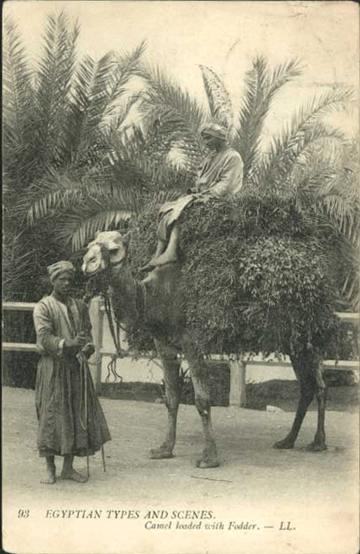
Postcard from about 1911
Category Archives: Travel
Ibn al-Mujâwir and the al-Huthi Rebellion
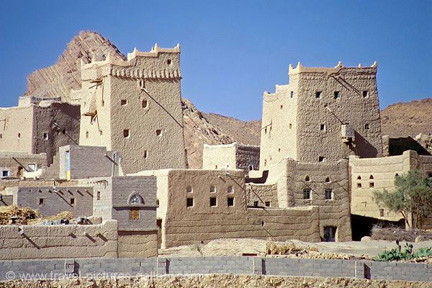
Traditional buildings in Sa‘da, Yemen
Over the past few years a major civil war has been simmering, at times brewing over into neighboring Saudi Arabia, in the north of Yemen. It has been called the al-Huthi rebellion and much of the fighting took place around the historic town of Sa‘da, the main entry of the Zaydi imams in the 10th century C.E. The exquisite travel text of Ibn al-Mujâwir, penned and quilled in the early 13th century, has a brief account of the overall region. Here is what Ibn al-Mujâwir, as ably translated by G. Rex Smith, said:
A description of these areas. The [previous] informant, [al-Kirmani], informed me as follows: All these areas [are made up of] settlements similar in size to one another to a greater or lesser degree. Each settlement has its own people. Every Arab tribal group and even bedouin section is [represented] in a settlement. As a result of their behaving badly [towards others], no one can settle with them, either on a temporary or a permanent basis.
A stronghold of stone and plaster has been built in every settlement and everyone living in the settlement has a store in the stronghold in which he keeps all his possessions, taking only from it what he needs on a daily basis. the inhabitants of the settlement surround the stronghold on all four sides. Each settlement is ruled over by an old shaykh of some power, clever and intelligent. When he gives a ruling, no one else shares in, nor opposes, what he advises them to do and what judgement he gives. There is no other authority ruling over all those in these areas and they pay no tax, nor do they hand over any levy at all, except whatever one wishes. thus they are constantly fighting, one getting the better of another’s wealth and the relatives of Zayd taking the wealth of ‘Amr. They do this all the time.
Their crops are wheat and barley; their trees are vines, pomegranates and almonds. All [kinds] of fruits and choice things are to be found among them. Their food is ghee and honey and they [bask] in their God[-given] ease and security. They are tribes who go back to Qahtân and others in their family trees.
Quoted by Ibn al-Mujâwir in his early 13th century travel text, translated by G. Rex Smith, A Traveler in Thirteenth-Century Arabia: Ibn al-Mujâwir’s Târîkh al-Mustabsir (London: The Hakluyt Society, 2008), p. 65.
Manakha to Machu Pichu

The blog Shadjar Al Noor has a lovely combination of photographs showing the similarities between the highlands of Yemen and of Peru. Check out the photographs here.
Alger Postcard
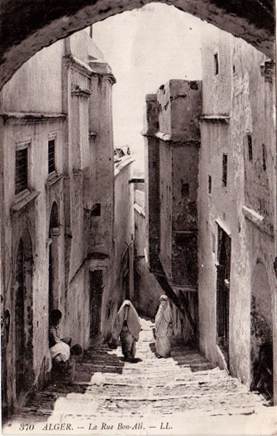
While looking over the postcards my grandmother saved from the start of the last century, I came across a beautiful street scene in Algiers, reproduced above. The card was sent from Italy in July, 1914 so it was obviously printed before then. It was addressed to my grandmother’s aunt, whose papers my grandmother inherited. The message itself is interesting in large part because it is so ordinary. The message reads:
Rome, 7/19/14
Dear Ida,
We have had a safe and happy journey so far, enjoying the beautiful stars en route. Went thro’ an Arab St. like this. I have bought some statuary which is being sent home to your address, and of necessity the duty, 75 cents about, must be paid at that end of the line. Am sorry to ask you to do it, but see no other way. We have seen some of the wonders of the “Eternal City.” Move on to Pisa and Florence tomorrow. A. K. Joy
Following Seward’s Folly: #4 The Dome of the Rock
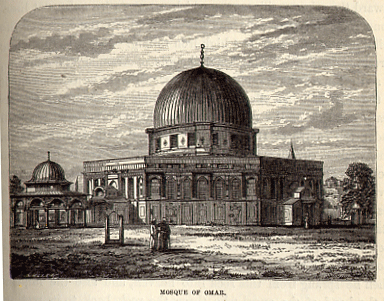
Illustration of Cairo from Seward’s Travels (1873)
William H. Seward, the American Secretary of State who is forever linked with the “folly†of acquiring Alaska from the Russians, spent a year traveling around the world near the end of his life. In three previous posts I posted the comments he and his daughter made about India and Aden, and Egypt. The journey continued to Palestine and the city of Jerusalem:
Yussef Effendi, with the brother and secretary of the pacha, attended us to the Mosque of Omar. It is only within the last five years that this mosque, scarcely less sacred in the eyes of Mussulmans than the Church of the Holy Sepulchre is in ours, has been opened to Christian travelers. Even now a careful, though somewhat disguised surveillance, is practiced over them. The mosque stands in an area enclosed with a high, parapeted wall, overlooking the vally of Jehoshaphat, and confronting the Mount of Olives. This occupies one-sixth of the land of the entire city. On the eastern side of this wall is a gate-way, built of marble, called by the Mussulmans the “Golden Gate,†which they are fond of representing as the “gate of the temple called Beautiful,†but its modern architecture does not support that claim. It is only interesting from the tradition that it was closed with the Roman conquest, and has never been reopened. The so-called Mosque of Omar is not single. It consists of two distinct mosques, placed at some distance from each other – the one here named Kubbet-es-Sukhrah, or “the Dome of the Rock,†commonly called the Mosque of Omar, and the Mosque-el-Aqsa. Though differing entirely from the Church of the Holy Sepulchre, the Mosque of Omar is not less unique and peculiar in its sacred antiquities. Twelve hundred years ago, on the surrender of the Greek Patriach, the Caliph Omar demanded to be shownt he site of the Jewish temple. He was taken to the sacred rock, he knelt and prayed over it, and he built over it a mosque, which, with subsequent repairs, is the present “Dome of the Rock,†or Mosque of Omar. In architectural design and execution it rivals the finest in Cairo and Constantinople. Continue reading Following Seward’s Folly: #4 The Dome of the Rock
Following Seward’s Folly: #3 Confederates in Cairo
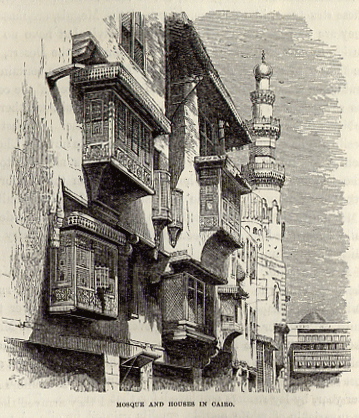
Illustration of Cairo from Seward’s Travels (1873)
William H. Seward, the American Secretary of State who is forever linked with the “folly†of acquiring Alaska from the Russians, spent a year traveling around the world near the end of his life. In two previous posts I posted the comments he and his daughter made about India and Aden, but their trip continued up the Red Sea to Egypt. While in Cairo, Mr. Seward received the esteemed protocol of a traveling diplomat, but in Cairo there came a most civil surprise:
The Americans in Egypt are a mixed though interesting family. The Khédive is reorganizing his army on the Western system of evolution and tactics. Continue reading Following Seward’s Folly: #3 Confederates in Cairo
On our terrorism problem

by Stephen M. Walt, Foreign Policy, January 8, 2010
Declaring that “the buck stops with me,” President Obama announced a set of new directives in response to the foiled bombing of Northwest Flight 253 by the now-infamous “underpants bomber.” The list of presidential orders is mostly unexceptionable, and may even make a repeat performance less likely. Of course, if al Qaeda is even remotely strategic, trying an exact repeat of this attempt would be silly. Instead, they’ll study the new procedures, look for holes in them, and try some new variation. The good news is that air travel will still be incredibly safe, and no sensible person should alter their normal travel plans because they are worried about the “terrorist threat.”
What’s missing from Obama’s list of new initiatives is any sense that U.S. foreign policy might need some rethinking too. There are several dimensions to the terrorism problem, only one of which are the various measures we take to “harden the target” here at home. Why? Because bombing airliners and other acts of terrorism are just tactics; they aren’t al Qaeda’s real raison d’être. Their goal, as veteran foreign affairs correspondent William Pfaff recently reminded us, is trying to topple various Arab governments that al Qaeda regards as corrupt and beholden to us and establish some unified Islamic caliphate. As Pfaff notes, this is a fanciful objective, but still one that can cause us a certain amount of trouble and grief. And if they can get us to act in ways that undermine those governments (even when we think we are trying to help them), then their objectives are advanced and ours are hindered. Continue reading On our terrorism problem
Following Seward’s Folly: #2 Hopeless Arabia
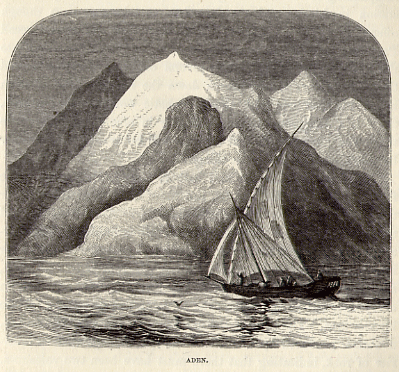
Illustration from Seward’s Travels (1873)
William H. Seward, the American Secretary of State who is forever linked with the “folly†of acquiring Alaska from the Russians, spent a year traveling around the world near the end of his life. In a previous post I recorded his comments on the British rule in India, as reported by his daughter. On April 27, 1871 the Seward party neared the Yemeni port (and British fueling station) of Aden. Here is how the approach is recorded by Ms. Seward:
April 27th. – After eight months travel in the incomprehensible East, with its stagnant civilization, we are now passing into another region still more incomprehensible and hopeless.
On the right hand is Yemen, once ‘Arabia the happy,’ and still known in poetry as a land of light and beauty, but now the dwelling of Arab hordes, who are sinking every day deeper into barbarism. On the left, wee are passing Somali, that part of Africa which stretches from Mozambique to Abyssinia. Continue reading Following Seward’s Folly: #2 Hopeless Arabia